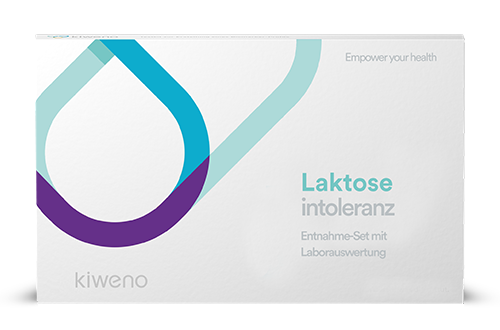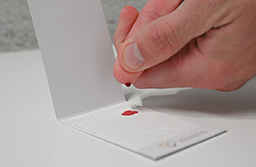How it works
Laboratory quality for home
With this kiweno home laboratory test you can safely and easily take a saliva sample and rely on the professional, discreet evaluation in our German partner laboratory.
FAQ
What is lactose intolerance?
Lactose intolerance is a disordered utilization of milk sugar (lactose). The intolerance occurs due to a defect or deficiency of the enzyme lactase. If the organism does not have a sufficient amount of lactase to utilize lactose, the two-fold sugar cannot be split. The uncleaved lactose thus reaches the large intestine, where it does not really belong. Consequently, hydrogen, carbon dioxide and short-chain fatty acids are formed in the large intestine.
What are the symptoms of lactose intolerance?
Typical symptoms are flatulence, abdominal pain, diarrhea, bloating, constipation, skin blemishes and, in rarer cases, heartburn, fatigue, migraine and low back pain. These occur after the consumption of dairy products.
What is the difference between primary and secondary lactose intolerance?
Primary or hereditary adult lactose intolerance refers to a genetically determined lactase deficiency. Lactase production ceases with age and lactose can no longer be digested without symptoms after a certain point in time. This form of intolerance can be determined or ruled out with the kiweno lactose intolerance genetic test.
Secondary lactose intolerance is considered to be the result of intestinal damage. Lactase production is reduced due to damage to the intestinal mucosa and the same symptoms occur as in primary lactose intolerance. As soon as the intestinal mucosa has regenerated (intestinal rehabilitation), lactase can be produced again and lactose can be consumed without restriction.
What is the difference between lactose intolerance and milk incompatibility?
In lactose intolerance, there is a lack of lactase in the small intestine, which means that lactose cannot be broken down and thus cannot be absorbed into the blood. Symptoms (such as abdominal pain, flatulence, diarrhea) appear after 30-120 minutes after consumption of lactose-containing products.
An incompatibility is an excessive reaction of the immune system to protein components of food. In the case of milk, this would be casein, for example. Symptoms such as abdominal pain, diarrhea, but also headaches and skin rashes occur only after 6-72 hours of consumption. Food intolerances can be diagnosed with a blood test.
What is the difference between lactose and casein?
Lactose is a sugar contained in milk and dairy products, whereas casein is a protein component of milk.
Note: The kiweno incompatibility test* tests, among other things, for the milk protein casein, but not for milk sugar (lactose). The kiweno lactose intolerance genetic test, in turn, determines whether you may suffer from primary lactose intolerance.
* The kiweno incompatibility test is available exclusively in Austria.
What is examined with the kiweno lactose intolerance genetic test?
In the kiweno lactose intolerance genetic test procedure, the “LCT gene (-13910-T/C) polymorphism” is examined without exception. This section of the DNA strand contains the necessary information about a possible genetic lactose intolerance. No further genetic examinations of the sample material are performed.
What does real time PCR mean?
In a polymerase chain reaction (PCR), a specific section of the DNA strand is isolated and multiplied. To find out which allele (gene variant) is present, a dye is added during the multiplication, which dissolves again when the sample is heated (melting curve analysis). Since the different genotypes have different ‘melting points’ and thus the color disappears at different temperatures, the process becomes measurable.
By copying the gene variant (including the dye) millions of times and then heating it (melting curve analysis), it becomes visible which variant is present and a test result is obtained with corresponding medical consequences.
What does the result of the kinweo lactose intolerance genetic test tell me?
The test result of the lactose intolerance genetic test is a laboratory-analysed finding that describes the presence or absence of a specific mutation. The necessary medical consequences can then be derived from this. In the kiweno lactose intolerance genetic test, the following three results may be present:
Genotype homozygous C/C: hereditary adult (primary) lactose intolerance confirmed with corresponding clinical symptoms.
Genotype heterozygous T/C: no evidence of hereditary adult (primary) lactose intolerance. Carriers of this heterozygous genotype show reduced lactase activity, which is not considered a predisposition for lactose intolerance.
Genotype homozygous T/T: no indication of hereditary adult (primary) lactose intolerance.
What happens to the sample material?
The certified partner laboratory of kiweno uses the genetic sample exclusively for the initiated genetic analysis (“Investigation of the LCT gene (-13910-T/C) polymorphism”). No further genetic analysis of the sample material will be performed. The sample material will be destroyed immediately after completion of this examination.
Note: In order to ensure maximum data security, the result will also be processed purely anonymously with the 16-digit identification code provided.











